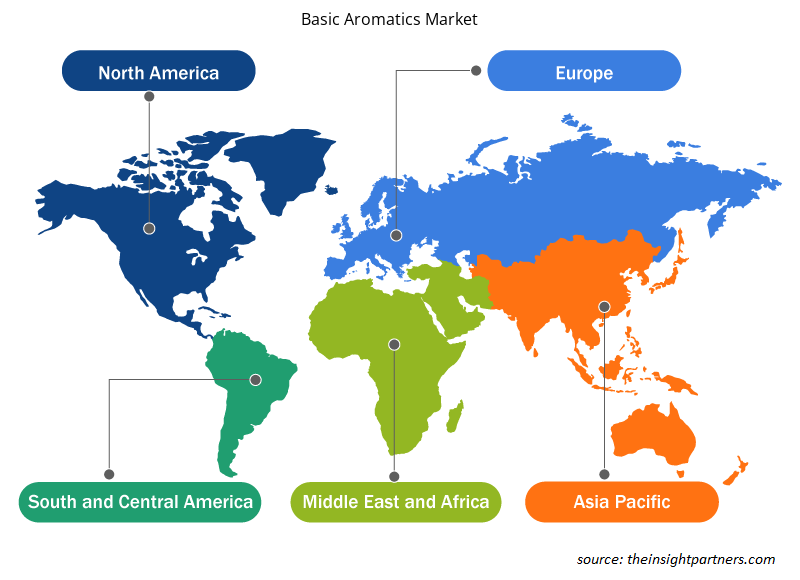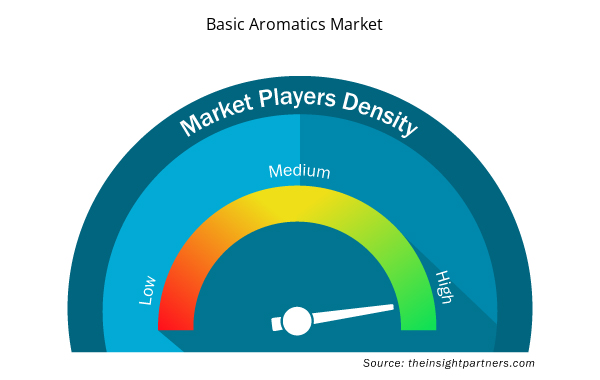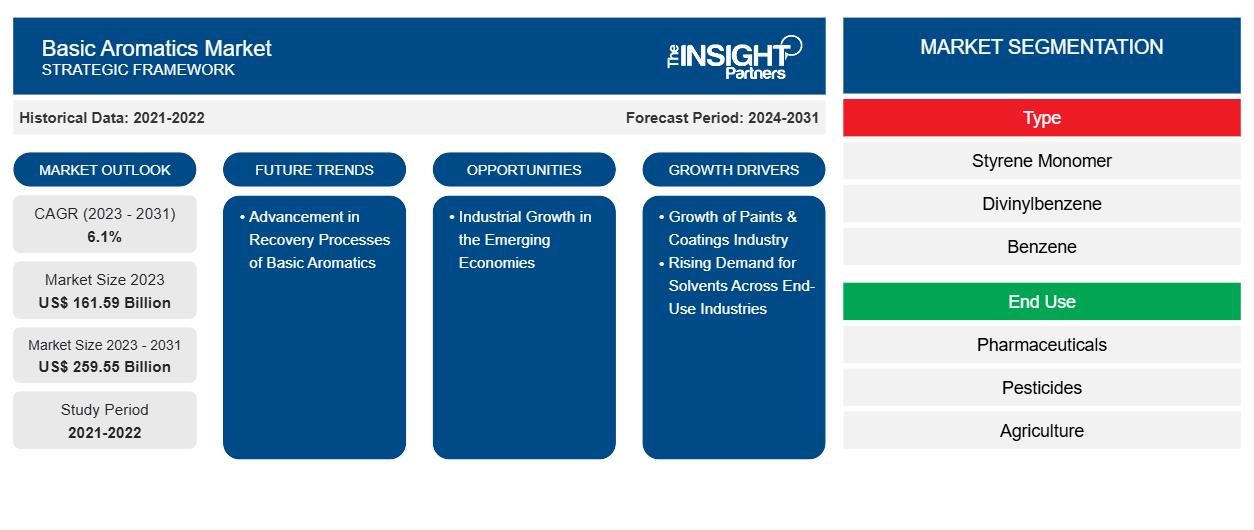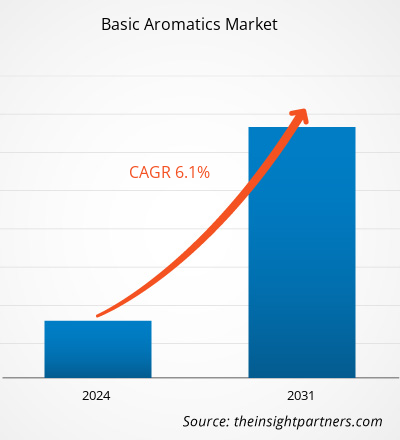من المتوقع أن يصل حجم سوق العطريات الأساسية إلى 259.55 مليار دولار أمريكي بحلول عام 2031 من 161.59 مليار دولار أمريكي في عام 2023. ومن المتوقع أن يسجل السوق معدل نمو سنوي مركب بنسبة 6.1٪ خلال الفترة 2023-2031. أدى التقدم في عمليات استعادة العطريات الأساسية بتقنيات مثل الإصلاح الحفزي المستمر إلى تحسين العائد والاستقرار، ومن المرجح أن يجلب اتجاهات جديدة إلى سوق العطريات الأساسية.
تحليل سوق العطريات الأساسية
تُستخدم الدهانات والطلاءات لأغراض الديكور وتعزيز خصائص السطح مثل مقاومة التآكل ومقاومة الخدش والالتصاق والمظهر ومقاومة الماء. تُستخدم الدهانات والطلاءات بشكل متزايد في الصناعات النهائية مثل البناء والأثاث والسيارات والنقل والتطبيقات الصناعية الأخرى. تلعب المواد العطرية الأساسية مثل البنزين والتولوين والزيلين دورًا رئيسيًا في صناعة الدهانات والطلاءات. يستخدم البنزين كمادة أولية لإنتاج العديد من الراتنجات والبوليمرات، مثل الستيرين، وهي مكونات رئيسية في تركيبات الدهانات والطلاءات. وبالتالي، فإن صناعة الدهانات والطلاءات المزدهرة تدفع نمو سوق المواد العطرية الأساسية .
نظرة عامة على سوق العطور الأساسية
المركبات العطرية الأساسية هي مركبات هيدروكربونية حلقية ذات حلقات بنزين. ومن بين المركبات العطرية الأساسية الأكثر استخدامًا البنزين والتولوين والزيلين والكريسول والبيريدين. تُستخدم المركبات العطرية الأساسية، وهي البنزين والزيلين، لإنتاج المبيدات الحشرية. ويُستخدم البنزين في المقام الأول كمذيب في صناعة الأدوية للتخليق الكيميائي. ويُستخدم البنزين أيضًا لإنتاج المطاط والأصباغ والأدوية ومواد التشحيم. تُستخدم المركبات العطرية الأساسية في إنتاج المواد الكيميائية المستخدمة في البناء مثل المواد اللاصقة والورنيش والدهانات والطلاءات.
قم بتخصيص هذا التقرير ليناسب متطلباتك
ستحصل على تخصيص لأي تقرير - مجانًا - بما في ذلك أجزاء من هذا التقرير، أو تحليل على مستوى الدولة، وحزمة بيانات Excel، بالإضافة إلى الاستفادة من العروض والخصومات الرائعة للشركات الناشئة والجامعات
- احصل على أهم اتجاهات السوق الرئيسية لهذا التقرير.ستتضمن هذه العينة المجانية تحليلاً للبيانات، بدءًا من اتجاهات السوق وحتى التقديرات والتوقعات.
العوامل المحركة والفرص في سوق العطريات الأساسية
ارتفاع الطلب على المذيبات في مختلف الصناعات ذات الاستخدام النهائي
يتأثر الطلب على المواد العطرية الأساسية مثل البنزين والتولوين والزيلين كمذيبات بعدة عوامل، مثل تنوعها وكفاءتها واستخدامها في مختلف الصناعات النهائية. جعلت خصائص قابلية ذوبان المواد العطرية الأساسية هذه المركبات مثالية للعديد من التطبيقات في القطاعات الكيميائية والصيدلانية وغيرها من قطاعات التصنيع. تلعب قدرة المواد العطرية الأساسية على إذابة مجموعة واسعة من المركبات العضوية دورًا مهمًا في إنتاج الدهانات والطلاءات والمواد اللاصقة. يمكن استخدام الزيلين المختلط كمذيبات وفي صناعات الطباعة والمطاط والجلود. كما تستخدم الزيلين عالية النقاء كمنتج تنظيف في إنتاج المكونات الإلكترونية. يستخدم التولوين بدرجة النترتة كمذيب وأيضًا في إنتاج الفينول، وخاصة في أوروبا. في صناعة الطباعة، تعد المواد العطرية الأساسية مكونات أساسية في صياغة أحبار الطباعة. يستخدم التولوين على نطاق واسع كمذيب في أحبار الطباعة بالحفر نظرًا لقدرته الممتازة على الذوبان وخصائص الجفاف السريع. في صناعة المطاط، يتم استخدام المواد العطرية الأساسية كمذيبات في عمليات البلمرة لتصنيع المطاط الصناعي، مثل مطاط البيوتادين ومطاط ستيرين-بيوتادين.
النمو الصناعي في الاقتصادات الناشئة
ومن المتوقع أن ينمو قطاع التصنيع المتقدم في منطقة آسيا والمحيط الهادئ في السنوات القادمة. وتعتبر المواد العطرية الأساسية مثل البنزين والتولوين والزيلين من المواد الخام الرئيسية المستخدمة في إنتاج الألياف الاصطناعية والمواد الكيميائية والمطاط والمواد اللاصقة والدهانات والطلاءات. ويستخدم التولوين لإنتاج الأدوية والعقاقير. كما تستخدم المواد العطرية الأساسية في إنتاج الألياف الاصطناعية مثل النايلون والبوليستر والراتنجات الاصطناعية مثل البولي إيثيلين تيريفثالات والبوليسترين وأكريلونيتريل بوتادين ستيرين. وقد نما الناتج الصناعي في منطقة آسيا والمحيط الهادئ مع استمرار الشركات في توسيع بصمتها التصنيعية في مختلف البلدان في جميع أنحاء المنطقة. وتجتذب العديد من المبادرات والسياسات الداعمة التي أطلقتها حكومات بلدان مختلفة في منطقة آسيا والمحيط الهادئ الاستثمار الأجنبي المباشر في العديد من القطاعات مثل البلاستيك والمنسوجات والمطاط والدهانات والطلاءات والمستحضرات الصيدلانية والمواد الكيميائية. وقد حددت العديد من البلدان أهدافًا طموحة لمساهمة الناتج المحلي الإجمالي لقطاع التصنيع.
تقرير تحليل تجزئة سوق العطريات الأساسية
إن القطاعات الرئيسية التي ساهمت في استخلاص تحليل سوق العطريات الأساسية هي النوع والاستخدام النهائي.
- يتم تقسيم سوق المواد العطرية الأساسية، بناءً على النوع، إلى مونومر ستيرين، وديفينيل بنزين، وبنزين، وتولوين، وزيلين، وكريسول، وبيريدين. احتل قطاع الزيلين الحصة الأكبر من السوق في عام 2023.
- من حيث الاستخدام النهائي، يتم تقسيم السوق إلى المستحضرات الصيدلانية والمبيدات الحشرية والزراعة والأغذية والمشروبات ومستحضرات التجميل والعناية الشخصية والدهانات والطلاءات والمذيبات. هيمن قطاع المذيبات على سوق العطور الأساسية في عام 2023.
تحليل حصة سوق العطريات الأساسية حسب المنطقة الجغرافية
ينقسم النطاق الجغرافي لتقرير سوق العطريات الأساسية بشكل أساسي إلى خمس مناطق: أمريكا الشمالية، ومنطقة آسيا والمحيط الهادئ، وأوروبا، والشرق الأوسط وأفريقيا، وأمريكا الجنوبية والوسطى.
استحوذت منطقة آسيا والمحيط الهادئ على أكبر حصة سوقية في عام 2023 ومن المتوقع أن تسجل أعلى معدل نمو سنوي مركب خلال الفترة المتوقعة. ويعزى نمو السوق في المنطقة إلى زيادة الطلب على هذه الصناديق من صناعة الأدوية. ووفقًا لتقرير Invest India، من حيث إنتاج الأدوية من حيث الحجم، تحتل صناعة الأدوية في الهند المرتبة الثالثة على مستوى العالم وبلغت قيمتها 50 مليار دولار أمريكي في عام 2023.
رؤى إقليمية حول سوق العطور الأساسية
لقد قام المحللون في Insight Partners بشرح الاتجاهات والعوامل الإقليمية المؤثرة على سوق العطريات الأساسية طوال فترة التوقعات بشكل شامل. يناقش هذا القسم أيضًا قطاعات سوق العطريات الأساسية والجغرافيا في جميع أنحاء أمريكا الشمالية وأوروبا ومنطقة آسيا والمحيط الهادئ والشرق الأوسط وأفريقيا وأمريكا الجنوبية والوسطى.

- احصل على البيانات الإقليمية المحددة لسوق العطريات الأساسية
نطاق تقرير سوق العطريات الأساسية
| سمة التقرير | تفاصيل |
|---|---|
| حجم السوق في عام 2023 | 161.59 مليار دولار أمريكي |
| حجم السوق بحلول عام 2031 | 259.55 مليار دولار أمريكي |
| معدل النمو السنوي المركب العالمي (2023 - 2031) | 6.1% |
| البيانات التاريخية | 2021-2022 |
| فترة التنبؤ | 2024-2031 |
| القطاعات المغطاة | حسب النوع
|
| المناطق والدول المغطاة | أمريكا الشمالية
|
| قادة السوق وملفات تعريف الشركات الرئيسية |
|
كثافة اللاعبين في السوق: فهم تأثيرها على ديناميكيات الأعمال
يشهد سوق العطور الأساسية نموًا سريعًا، مدفوعًا بالطلب المتزايد من جانب المستخدم النهائي بسبب عوامل مثل تفضيلات المستهلكين المتطورة والتقدم التكنولوجي والوعي المتزايد بفوائد المنتج. ومع ارتفاع الطلب، تعمل الشركات على توسيع عروضها والابتكار لتلبية احتياجات المستهلكين والاستفادة من الاتجاهات الناشئة، مما يؤدي إلى زيادة نمو السوق.
تشير كثافة اللاعبين في السوق إلى توزيع الشركات أو المؤسسات العاملة في سوق أو صناعة معينة. وهي تشير إلى عدد المنافسين (اللاعبين في السوق) الموجودين في مساحة سوق معينة نسبة إلى حجمها أو قيمتها السوقية الإجمالية.
الشركات الرئيسية العاملة في سوق العطريات الأساسية هي:
- شركة داو للكيماويات
- شركة إكسون موبيل
- شركة لانكسيس ايه جي
- شركة ساسول المحدودة
- شركة ليونديل باسيل للصناعات
- باسف اس اي
إخلاء المسؤولية : الشركات المذكورة أعلاه ليست مرتبة بأي ترتيب معين.

- احصل على نظرة عامة على أهم اللاعبين الرئيسيين في سوق العطريات الأساسية
أخبار سوق العطريات الأساسية والتطورات الأخيرة
يتم تقييم سوق العطور الأساسية من خلال جمع البيانات النوعية والكمية بعد البحث الأولي والثانوي، والتي تتضمن منشورات الشركات المهمة وبيانات الجمعيات وقواعد البيانات. فيما يلي بعض التطورات في سوق العطور الأساسية:
- حصلت شركة BioBTX، وهي شركة رائدة في تطوير تكنولوجيا المواد العطرية المتجددة في هولندا، على أكثر من 86.59 مليون دولار أمريكي لإطلاق أول مصنع لها على نطاق تجاري. سيمول هذا الاستثمار أول مصنع للمواد الكيميائية المتجددة في العالم باستخدام تقنية ICCP المبتكرة من BioBTX لإنتاج المواد العطرية المستدامة (BTX) من النفايات البلاستيكية والكتلة الحيوية. (المصدر: BioBTX، أخبار الشركة، يونيو 2024)
- أتمت شركة INEOS، إحدى أكبر شركات التصنيع في العالم، عملية شراء أعمال العطريات والأسيتيل العالمية من شركة BP مقابل 5 مليارات دولار أمريكي. (المصدر: INEOS، بيان صحفي، يناير 2021)
تقرير سوق العطريات الأساسية والتغطية والنتائج المتوقعة
يقدم تقرير "حجم سوق العطريات الأساسية والتوقعات (2021-2031)" تحليلاً مفصلاً للسوق يغطي المجالات التالية:
- حجم سوق العطور الأساسية والتوقعات لجميع قطاعات السوق الرئيسية التي يغطيها النطاق
- اتجاهات سوق العطريات الأساسية، بالإضافة إلى ديناميكيات السوق مثل المحركات والقيود والفرص الرئيسية
- تحليل مفصل لقوى بورتر الخمس ونقاط القوة والضعف والفرص والتهديدات
- تحليل أساسي لسوق العطريات يغطي اتجاهات السوق الرئيسية، وإطار الدولة، واللاعبين الرئيسيين، واللوائح، والتطورات الأخيرة في السوق.
- تحليل المشهد الصناعي والمنافسة الذي يغطي تركيز السوق، وتحليل خريطة الحرارة، واللاعبين البارزين، والتطورات الأخيرة لسوق العطريات الأساسية
- ملفات تعريف الشركة التفصيلية
- التحليل التاريخي (سنتان)، السنة الأساسية، التوقعات (7 سنوات) مع معدل النمو السنوي المركب
- تحليل PEST و SWOT
- حجم السوق والقيمة / الحجم - عالميًا وإقليميًا وقطريًا
- الصناعة والمنافسة
- مجموعة بيانات Excel



Report Coverage
Revenue forecast, Company Analysis, Industry landscape, Growth factors, and Trends

Segment Covered
This text is related
to segments covered.

Regional Scope
North America, Europe, Asia Pacific, Middle East & Africa, South & Central America

Country Scope
This text is related
to country scope.
الأسئلة الشائعة
The solvent segment held the largest share in the global basic aromatics market in 2023.
The xylene segment held the largest share in the global basic aromatics market in 2023.
The market is expected to register a CAGR of 6.1% during 2023–2031.
The Dow Chemical Co, Exxon Mobil Corp, Lanxess AG, Sasol Ltd, Lyondellbasell Industries NV, BASF SE, Nippon Steel Corp, Shell Plc, Ineos Group Holdings SA, and Jubilant Ingrevia Ltd are among the leading market players.
The advancement in recovery processes of basic aromatics is expected to emerge as a future trend in the market.
The continuous growth of the paints & coatings industry fuels the basic aromatics market growth.
Trends and growth analysis reports related to Chemicals and Materials : READ MORE..
The List of Companies - Basic Aromatics Market
- The Dow Chemical Co
- Exxon Mobil Corp
- Lanxess AG
- Sasol Ltd
- Lyondellbasell Industries NV
- BASF SE
- Nippon Steel Corp
- Shell Plc
- Ineos Group Holdings SA
- Jubilant Ingrevia Ltd
The Insight Partners performs research in 4 major stages: Data Collection & Secondary Research, Primary Research, Data Analysis and Data Triangulation & Final Review.
- Data Collection and Secondary Research:
As a market research and consulting firm operating from a decade, we have published and advised several client across the globe. First step for any study will start with an assessment of currently available data and insights from existing reports. Further, historical and current market information is collected from Investor Presentations, Annual Reports, SEC Filings, etc., and other information related to company’s performance and market positioning are gathered from Paid Databases (Factiva, Hoovers, and Reuters) and various other publications available in public domain.
Several associations trade associates, technical forums, institutes, societies and organization are accessed to gain technical as well as market related insights through their publications such as research papers, blogs and press releases related to the studies are referred to get cues about the market. Further, white papers, journals, magazines, and other news articles published in last 3 years are scrutinized and analyzed to understand the current market trends.
- Primary Research:
The primarily interview analysis comprise of data obtained from industry participants interview and answers to survey questions gathered by in-house primary team.
For primary research, interviews are conducted with industry experts/CEOs/Marketing Managers/VPs/Subject Matter Experts from both demand and supply side to get a 360-degree view of the market. The primary team conducts several interviews based on the complexity of the markets to understand the various market trends and dynamics which makes research more credible and precise.
A typical research interview fulfils the following functions:
- Provides first-hand information on the market size, market trends, growth trends, competitive landscape, and outlook
- Validates and strengthens in-house secondary research findings
- Develops the analysis team’s expertise and market understanding
Primary research involves email interactions and telephone interviews for each market, category, segment, and sub-segment across geographies. The participants who typically take part in such a process include, but are not limited to:
- Industry participants: VPs, business development managers, market intelligence managers and national sales managers
- Outside experts: Valuation experts, research analysts and key opinion leaders specializing in the electronics and semiconductor industry.
Below is the breakup of our primary respondents by company, designation, and region:

Once we receive the confirmation from primary research sources or primary respondents, we finalize the base year market estimation and forecast the data as per the macroeconomic and microeconomic factors assessed during data collection.
- Data Analysis:
Once data is validated through both secondary as well as primary respondents, we finalize the market estimations by hypothesis formulation and factor analysis at regional and country level.
- Macro-Economic Factor Analysis:
We analyse macroeconomic indicators such the gross domestic product (GDP), increase in the demand for goods and services across industries, technological advancement, regional economic growth, governmental policies, the influence of COVID-19, PEST analysis, and other aspects. This analysis aids in setting benchmarks for various nations/regions and approximating market splits. Additionally, the general trend of the aforementioned components aid in determining the market's development possibilities.
- Country Level Data:
Various factors that are especially aligned to the country are taken into account to determine the market size for a certain area and country, including the presence of vendors, such as headquarters and offices, the country's GDP, demand patterns, and industry growth. To comprehend the market dynamics for the nation, a number of growth variables, inhibitors, application areas, and current market trends are researched. The aforementioned elements aid in determining the country's overall market's growth potential.
- Company Profile:
The “Table of Contents” is formulated by listing and analyzing more than 25 - 30 companies operating in the market ecosystem across geographies. However, we profile only 10 companies as a standard practice in our syndicate reports. These 10 companies comprise leading, emerging, and regional players. Nonetheless, our analysis is not restricted to the 10 listed companies, we also analyze other companies present in the market to develop a holistic view and understand the prevailing trends. The “Company Profiles” section in the report covers key facts, business description, products & services, financial information, SWOT analysis, and key developments. The financial information presented is extracted from the annual reports and official documents of the publicly listed companies. Upon collecting the information for the sections of respective companies, we verify them via various primary sources and then compile the data in respective company profiles. The company level information helps us in deriving the base number as well as in forecasting the market size.
- Developing Base Number:
Aggregation of sales statistics (2020-2022) and macro-economic factor, and other secondary and primary research insights are utilized to arrive at base number and related market shares for 2022. The data gaps are identified in this step and relevant market data is analyzed, collected from paid primary interviews or databases. On finalizing the base year market size, forecasts are developed on the basis of macro-economic, industry and market growth factors and company level analysis.
- Data Triangulation and Final Review:
The market findings and base year market size calculations are validated from supply as well as demand side. Demand side validations are based on macro-economic factor analysis and benchmarks for respective regions and countries. In case of supply side validations, revenues of major companies are estimated (in case not available) based on industry benchmark, approximate number of employees, product portfolio, and primary interviews revenues are gathered. Further revenue from target product/service segment is assessed to avoid overshooting of market statistics. In case of heavy deviations between supply and demand side values, all thes steps are repeated to achieve synchronization.
We follow an iterative model, wherein we share our research findings with Subject Matter Experts (SME’s) and Key Opinion Leaders (KOLs) until consensus view of the market is not formulated – this model negates any drastic deviation in the opinions of experts. Only validated and universally acceptable research findings are quoted in our reports.
We have important check points that we use to validate our research findings – which we call – data triangulation, where we validate the information, we generate from secondary sources with primary interviews and then we re-validate with our internal data bases and Subject matter experts. This comprehensive model enables us to deliver high quality, reliable data in shortest possible time.


 احصل على عينة مجانية لهذا التقرير
احصل على عينة مجانية لهذا التقرير